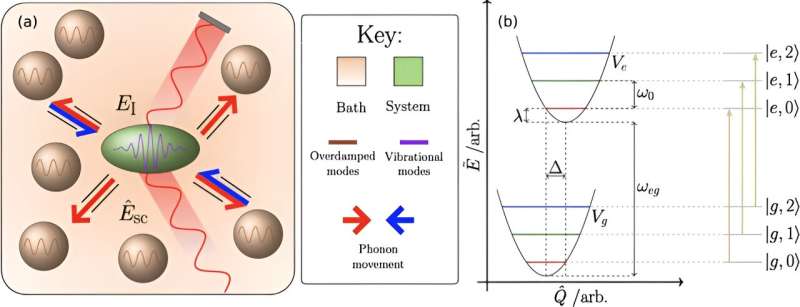This article has been reviewed according to Science X's editorial process and policies. Editors have highlighted the following attributes while ensuring the content's credibility:
fact-checked
peer-reviewed publication
proofread
How quantum light sees quantum sound

Researchers at the University of East Anglia have proposed a new way of using quantum light to "see" quantum sound.
A new paper published October 2 in Physical Review Letters reveals the quantum-mechanical interplay between vibrations and particles of light, known as photons, in molecules.
It is hoped that the discovery may help scientists better understand the interactions between light and matter on molecular scales. And it potentially paves the way for addressing fundamental questions about the importance of quantum effects in applications ranging from new quantum technologies to biological systems.
Dr. Magnus Borgh from UEA's School of Physics said, "There is a long-standing controversy in chemical physics about the nature of processes where energy from particles of light is transferred within molecules.
"Are they fundamentally quantum-mechanical or classical? Molecules are complex and messy systems, constantly vibrating. How do these vibrations affect any quantum-mechanical processes in the molecule?
"These processes are typically investigated using techniques that rely on polarization—the same property of light used in sunglasses to reduce reflections. But this is a classical phenomenon.
"Techniques from quantum optics, the field of physics that studies the quantum nature of light and its interactions with matter on the atomic scale, can offer a way to investigate genuine quantum effects directly in molecular systems."
Quantum behavior can be revealed by studying correlations in the emitted light from a molecule placed in a laser field. Correlations answer the question how likely it is that two photons are emitted very close together and can be measured using standard techniques.
Ben Humphries, Ph.D. student in theoretical chemistry, at UEA said, "Our research shows that when a molecule exchanges phonons—quantum-mechanical particles of sound—with its environment, this produces a recognizable signal in the photon correlations."
While photons are routinely created and measured in laboratories all over the world, individual quanta of vibrations, which are the corresponding particles of sound, phonons, cannot in general be similarly measured.
The new findings provide a toolbox for investigating the world of quantum sound in molecules.
Lead researcher Dr. Garth Jones, from UEA's School of Chemistry, said, "We have also computed correlations between photon and phonons.
"It would be very exciting if our paper could inspire the development of new experimental techniques to detect individual phonons directly," he added.
More information: Ben S. Humphries et al, Phonon Signatures in Photon Correlations, Physical Review Letters (2023). DOI: 10.1103/PhysRevLett.131.143601
Journal information: Physical Review Letters
Provided by University of East Anglia




















